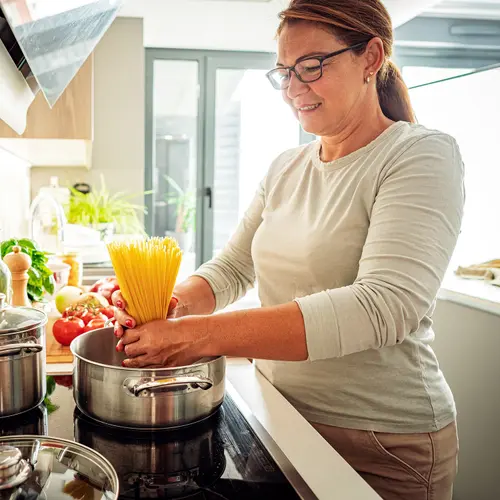Feelings of anxiousness or nervousness are common in both adults and children. But when those feelings start to be overwhelming and affect your daily life, you could have an anxiety disorder. Mood swings and debilitating worry are important signs to watch for.
Anxiety disorders in older adults are fairly common, affecting 10% to 20% of people. However, anxiety disorders often go undiagnosed. Anxiety is found more often than depression and cognitive disorders in older adults.
Generalized Anxiety Disorder (GAD) is the most common type of anxiety disorder diagnosed in older adults. This is followed by phobias, panic disorder, and Obsessive-Compulsive Disorder (OCD). These and Post Traumatic Stress Disorder (PTSD) are the most common types of anxiety disorders diagnosed.
Types of Anxiety Disorders
Having more anxiety as you age is a common issue in older adults. The most common types of anxiety disorders are:
Generalized Anxiety Disorder (GAD). This type of anxiety causes racing thoughts, constant worrying, and a feeling of hopelessness. Older adults with GAD aren’t able to sleep or concentrate as well. They also feel tired, irritable, and nauseous. They may also have to go to the bathroom often. Hot flashes and feeling out of breath are additional signs of GAD.
Phobias. This type of anxiety fills people with intense fear of a place, thing, or event. Often, these fears are irrational and are about things that do not pose a real threat.
Common types of phobias for older adults are fear of death, disaster, and danger to the family. A fear of dental procedures is also common. When facing these fears you might feel dizzy, have chest pain, or heart palpitations. Shortness of breath is also common.
Panic disorder. When an older adult has a panic disorder, they can get sudden feelings of terror. This feeling is often accompanied by a racing heart, chest pain, weakness, nausea, and feeling faint or dizzy.
Panic attacks happen randomly and are not necessarily triggered by anything. They usually peak within 10 minutes and then fade away. Older adults with this condition may feel like they’re having a heart attack or stroke and not want to be left alone.
Obsessive-compulsive disorder (OCD). OCD causes persistent and disturbing thoughts. Older adults with this condition will feel like they can only get control by doing repeated actions. OCD can also include overwhelming thoughts of possible violence or harm happening to a loved one.
Post-traumatic stress disorder (PTSD). This type of anxiety is caused by a traumatic event. In some cases, symptoms of the trauma may not emerge until months or even years after the event. Older adults may be triggered by a previous traumatic event after feeling helpless because of a new disability.
Symptoms of Anxiety in Older Adults
People of all ages will typically show the same signs of anxiety. Some types of disorders may have different symptoms. Common symptoms of an anxiety disorder include:
- Shakiness and panicky feeling
- Difficulty breathing, sweating, and nausea
- Dizziness or feeling lightheaded
- Digestion problems and chest pain
- Headaches and confusion
- Eye and vision problems
- Muscle tension, soreness, and fatigue
- Irrational thoughts
- Forgetfulness
- Irritability
- Avoidance of activities, places, people, and even thoughts that trigger anxiousness
- Changes in weight, appetite, or eating habits
- Inability to sleep
- Not wanting to leave home, withdrawal, and isolating themselves
- Obsessive thoughts and compulsive behavior
How to Manage Anxiety in Older Adults
Anxiety isn’t always caused by a specific trigger. It typically happens because of overwhelming environmental and situational factors. As older adults deal with frequent changes, they can become more anxious. Some common triggers for older adults include:
- Financial insecurity
- Health problems, immobility, or chronic pain
- Dementia
- Loss of independence and isolation
- End-of-life planning
- Grief and loss
Being aware of these triggers can help identify when you or a loved one might need help. Here are some other ways to help manage anxiety in older adults:
Learn about your anxiety disorder. Understanding what triggers feelings of anxiety and how to cope will help you recognize when you feel out of control. Therapy can help you learn ways to cope with your anxiety. You’ll learn relaxation methods and how to handle other stressors.
Create a social support network. Family, friends, and people nearby that you trust can be a helpful resource for you to turn to when you feel yourself losing control. They may also be able to help you identify stressful situations and know when to get you out of them.
Try to have a healthy, balanced life. Getting enough sleep, eating well, and staying active are important ways to manage your stress levels. Creating an active, balanced lifestyle with social interaction and hobbies you love can reduce stress and anxiety.
When to See Your Doctor
If you feel like your anxiety and nervousness are uncontrollable, you should contact your doctor. Your doctor can help diagnose you with an anxiety disorder and determine the right treatment plan for you.
Your doctor will refer you to a mental health professional. Your doctor may prescribe low dosages of medications for older adults to find the right dosage for your body. Psychotherapy may also be recommended to effectively manage your anxiety disorder.

